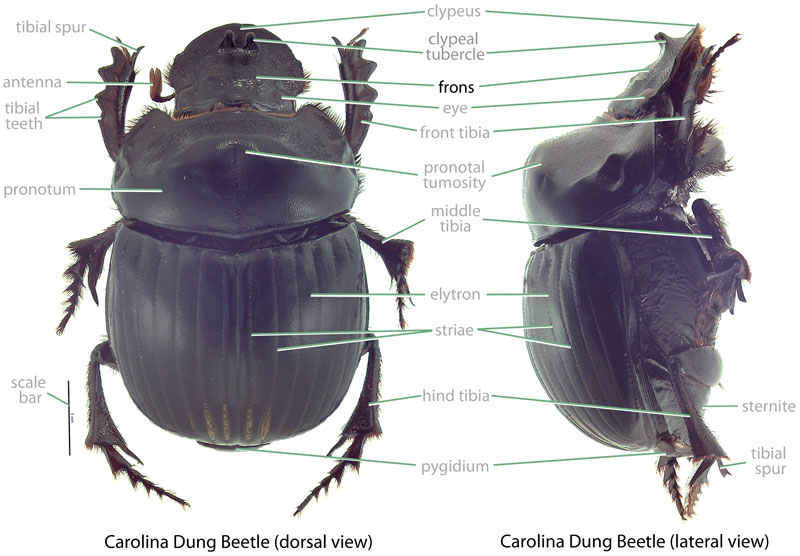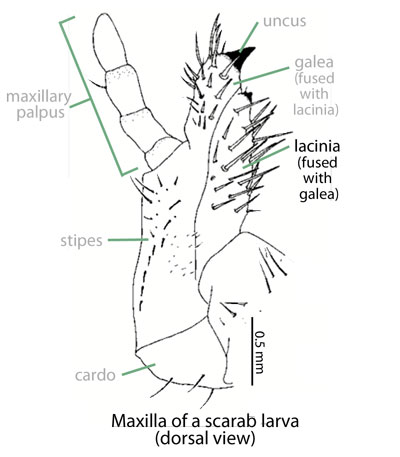Beneficial
none known
Family: Scarabaeidae Subfamily: Scarabaeinae Genus: Catharsius Species: Catharsius molossus (Linnaeus, 1789)
none available
Total body length 25.0–45.0 mm (0.98–1.80 in). Body shape elongate-oval; may be caked with dung. Color dull black. Clypeusclypeus:
part of the head anterior to the frons; the most anterior portion in dorsal view
 broadly rounded. Head of male with clypealclypeal:
broadly rounded. Head of male with clypealclypeal:
of, or referring to, the clypeus
horn; female lacking clypealclypeal:
of, or referring to, the clypeus
horn. Fronsfrons:
part of the head generally positioned between the eyes (posterior to the clypeus and anterior to the vertex) and visible dorsally
 lacking horns or tubercles in both sexes. Pronotumpronotum:
lacking horns or tubercles in both sexes. Pronotumpronotum:
the dorsal surface of the thorax
 with well-developed tumositytumosity:
with well-developed tumositytumosity:
mound-like protuberance or puffed-up appearance
and distinct horizontal ridge in both sexes; lateral margins with distinct horns in major male (reduced or lacking in minor males, lacking in female). ElytraElytra:
the hardened and chitinous wing-cover of a beetle that protect and overlie the flight wing
with indistinct striaestriae:
a longitudinal depressed line or furrow, often formed from numerous punctures that extends the length of an elytron
 .
.
Undescribed. For Scarabaeinae (Ritcher, 1966Ritcher, 1966:
Ritcher P. 1966. White grubs and their allies: a study of North American scarabaeoid larvae. Oregon State University Monographs, Studies in Entomology 4: 1-219.): Grub C-shaped, hump-backed, cylindrical, cream-colored. Maxillamaxilla:
set of paired mouthparts located posterior to the mandibles
with galeagalea:
outer branch or lobe of the maxilla
 and lacinialacinia:
and lacinialacinia:
inner portion of the maxilla distinctly separate. AntennaeAntennae:
distinctly separate. AntennaeAntennae:
paired sensory organ on head, formed from numerous segments
 with 4 or 5 apparent segments. Distaldistal:
with 4 or 5 apparent segments. Distaldistal:
situated away from the point of articulation, thus usually furthest from the body
segment of antennaantenna:
paired sensory organ on head, formed from numerous segments
 much reduced in size. Epipharynxepipharynx:
much reduced in size. Epipharynxepipharynx:
lobe on the interior surface of the labrum or clypeus
with tormaetormae:
in scarab larvae, sclerotized structures on the ends of the clypeolateral suture extending towards the mesal line
united mesallymesally:
at or near midline of body
, anterioranterior:
the front or forward; opposite of posterior
phoba present. Anal opening surrounded by fleshy lobes. Legs 2-segmented.
Southeastern Asia. This species is distributed widely through southeastern Asia, including India, southern China, Thailand, Vietnam, and Indonesia (Xu et al., 2002Xu et al., 2002:
Xu J, Liu Q, Jing H, Pang B, Yang J, Zhao G, Li H. 2002. Isolation of Escherichia coli O157:H7 from dung beetles Catharsius molossus . Microbial Immunology 47: 45-49.). Recently, this species was rediscovered in Singapore after nearly 40 years of searching (Ong et al. 2013).
None. This species feeds on dung as both an adult and larvalarva:
the immature form of an insect; in scarabs, also called grub or white grub; preceded by the egg stage, followed by the pupal stage
 (Ong et al. 2013).
(Ong et al. 2013).
Unlike many of the more familiar dung beetles that can occur in livestock pastures, this species is dependent upon primary and late-stage secondary rain forests (Ong et al. 2013). In Borneo, this species has declined in concert with the loss of primary forests (Davis, 2001). Catharsius molossus prefers the dung of large herbivores, constructing a brood burrow near fresh dung at night. Dung is then deposited in the burrow and impregnated with an egg (Ong et al. 2013).
None. This species recycles dung and is beneficial for ranching and farming in Hawaii. Being a dung feeder, this species poses no threat to crop or ornamental plants. Additionally, this species is not a threat to native dung beetles because none are known from Hawaii or Guam.
Recorded, not established. This species was imported into Hawaii in 1921 for evaluation as a biocontrol agent to help control populations of the horn fly (Haematobia irritans), a biting pest of livestock. However imported specimens failed to thrive, and none were released (Fullaway, 1921Fullaway, 1921:
Fullaway O. 1921. Horn fly control. The Hawaiian Forester and Agriculturist: Quarterly Magazine of Forestry, Entomology, Plant Inspection and Animal Industry 18: 219-221. full text (accessed 2015)).
Not established or recorded. This species has not been recorded in Guam.
This species was intentionally imported into Hawaii.
This species is somewhat like the similarly colored and sized Dichotomius carolinus. These two species are separated by examining the head (C. molossus with a single clypealclypeal:
of, or referring to, the clypeus
horn in males with females lacking a horn versus D. carolinus with pairedpaired:
in relation to bilateral symmetry: occurring on both sides of the body
clypealclypeal:
of, or referring to, the clypeus
tubercles in males and females with a tubercletubercle:
a small, conical knob or horn-like protuberance
on the fronsfrons:
part of the head generally positioned between the eyes (posterior to the clypeus and anterior to the vertex) and visible dorsally
 ), pronotumpronotum:
), pronotumpronotum:
the dorsal surface of the thorax
 (C. molossus major males with pronotal horns with minor males and females lacking horns versus D. carolinus always lacking pronotal horns), and elytraelytra:
(C. molossus major males with pronotal horns with minor males and females lacking horns versus D. carolinus always lacking pronotal horns), and elytraelytra:
the hardened and chitinous wing-cover of a beetle that protect and overlie the flight wing
(C. molossus with indistinct striaestriae:
a longitudinal depressed line or furrow, often formed from numerous punctures that extends the length of an elytron
 versus D. carolinus with distinct striae).
versus D. carolinus with distinct striae).
Sacrabaeus molossus Linnaeus, Catharsius abbrevatius Herbst in Jablonsky, Catharsius berbicaeus Herbst in Jablonsky, Catharsius janus Olivier, Catharsius ursus Fabricius
Report your observation of this beneficial species at our iNaturalist project.